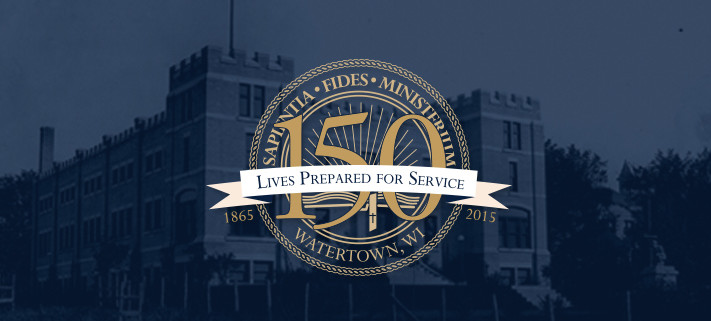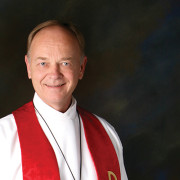Lives Prepared for Service: Part 1
LPS 150
Training the next generation of full-time church workers in Watertown, Wisconsin, began 150 years ago.
Matthew A. Crass
It was the early 1860s. One can almost imagine some words from a well-intended letter: “Dear President Bading, with our church body being in existence for only a little more than a decade, it does not seem as though we are ready to undertake an endeavor of such magnitude.”
One can almost hear President Bading’s friends speaking to him: “What are you thinking? The members of our fledgling synod are immigrants. They don’t have that kind of money. How can we possibly expect them even to build such a campus let alone pay for the ongoing operation of it? Oh, and you certainly are also well aware of the fact that we are in the midst of the Civil War, right?”
Some might have called him a visionary, while others might have said he was innovative. But Johannes Bading, WELS’ second synod president, preferred to think of himself as a gospel servant. Bading sought support for a plan—to build a campus in Watertown, Wisconsin, to prepare and train the next generation of pastors and teachers for spreading the gospel.
A SMALL BEGINNING
The pastors coming from Germany were few and often unreliable. In his report to the 1862 synod convention, Bading wrote, “We must dig a well in our land, in our synod, from which workers flow to us. . . . Let us make a small beginning, with faith in the Lord’s help.”
Even though Bading’s idea was at times met with apathy, uncertainty, or disagreement, he continued to plod, prepare, plant, and procure gifts. Above all, he proclaimed Christ. He knew that the Spirit would work as he willed through such preaching.
A small beginning was made. And the well was dug.
On Sept. 14, 1865, the campus of ministry in Watertown, Wisconsin, was dedicated. The school was established to serve as a seminary and a college, which would include a prep department. The five-acre campus had only one building known as the Kaffeemuehle because its shape resembled a coffee grinder. Within the Kaffeemuehle, 6 seminary students and 66 prep students (no college students yet because there were very few young men who had a high school education in 1865) ate, attended classes, worshiped, studied, and slept. At the dedication, Bading publicly praised God for the assured training of preachers of the gospel. He said, “The Lord will carry out to a glorious end the work that we have begun.”
A SOLID BASE
This profound truth has been made with these rather simple words: “The work of a minister of the gospel is this—to know the Word of God and the soul of the human being he serves. Then connect the two.” Of course, it is the Holy Spirit working through the gospel in Word and sacrament who makes such a connection. That is precisely why the Word of God remains paramount in the work of our WELS pastors, teachers, and staff ministers.
That’s what our forefathers thought and believed in 1865. The ministerial education of the students meant a heavy emphasis on Bible, doctrine, history, English, German, Latin, and even French. In 1524, Martin Luther wrote, “In proportion then as we value the gospel, let us zealously hold to the languages. For it was not without purpose that God caused his Scriptures to be set down in these two languages alone—the Old Testament Hebrew, the New Testament Greek. Now, if God did not despise them but chose them above all others for his word, then we too ought to honor them above all others.” As it is today, the study of Greek and Hebrew was critical to the formation of a gospel servant in 1865, so much so that Greek was taught in the prep department.
Martin Luther continued with his compelling words, “Let us be sure of this. We will not long preserve the gospel without the languages.” Board for Ministerial Education administrator Paul Prange wrote on the occasion of our seminary’s 150th anniversary two years ago, “I am unaware of any other Lutheran seminary that has remained orthodox for 150 years.” God has preserved the gospel among us. This is a testimony to God’s grace and the rich blessings he has given us as a synod in our ministerial education system.
A RICH HISTORY
The seminary graced the Watertown campus until 1870, before moving first to St. Louis, then to Milwaukee, and finally to Wauwatosa. For the past 86 years it has resided in Mequon, Wisconsin.
The college and prep department were modeled, not surprisingly, after the German Gymnasium schools. This included four years of study in the prep department and two in the college. Remnants of 1865 remain today as the high school students on the synod’s Watertown campus, known today as Luther Preparatory School, still use the Latin names from the German Gymnasium to identify their year of study. For example, the sophomores are called Quintaners (from the Latin for “fifth”) because in 1865 they would have looked forward to five more years of education at Watertown.
The college was first known as “Wisconsin University” and then “Northwestern University.” In 1910 the governing board changed its name to Northwestern College. Northwestern College remained the anchor of the Watertown campus for 130 years, until it was amalgamated in 1995 with Dr. Martin Luther College, our synod’s teacher training college in New Ulm, Minnesota. Since then our synod’s single college of ministry bears the name Martin Luther College (MLC).
Last May the Northwestern College Alumni Society held its annual meeting on the Watertown campus for the first time since the amalgamation. Daniel Balge, MLC’s academic dean for the pre-seminary program, addressed the group. In his remarks he related that “the spirit of Northwestern College lives on at MLC.” This continuing spirit is a fruit of the Holy Spirit. The Holy Spirit, who worked in the hearts of young men to offer themselves for the gospel ministry 150 years ago in Watertown, continues to work today in the young men and women at MLC.
BLESSINGS FROM GOD
The prep department has remained on the campus for 150 years and still continues with the same purpose: preparing students for the public ministry of the gospel.
In 1865, the people of our synod dug the well from which countless blessings have flowed from the hand of the Almighty. More than 3,500 pastors have received their training on the Watertown campus. The same is true for several thousand teachers and dedicated laypeople.
Ministerial education in WELS endured some challenging years in the late 1860s. But by 1872 the enrollment had grown to 156 students. The total enrollment of our synod’s four ministerial education schools today numbers approximately 1,500. The well has been dug very deep.
Johannes Bading served as synod president until 1889. He served on the governing board of Northwestern College until shortly before he entered glory in 1913. We still echo his words today: “The Lord will carry out to a glorious end the work which we begin.”
Matthew Crass, president of Luther Preparatory School, Watertown, Wisconsin, is a member at St. Luke, Watertown.
This is the first article in a three-part series discussing 150 years of ministerial education on the synod’s Watertown campus.
A sesquicentennial celebration of praise to God will be held at the Luther Prep gymnasium at 3 p.m. CST, Nov. 15. The synod’s four ministerial education school choirs will participate. The event will be livestreamed. Learn more at www.lps.wels.net.
SUBMIT YOUR STORY
Do you have a manuscript, idea, or story from your own life you’d like to share for use in Forward in Christ or on wels.net? Use our online form to share it to our editorial office for consideration.
SUBSCRIBE TO FORWARD IN CHRIST
Get inspirational stories, spiritual help, and synod news from Forward in Christ every month. Print and digital subscriptions are available from Northwestern Publishing House.
Author: Matthew A. Crass
Volume 102, Number 9
Issue: September 2015
Copyrighted by WELS Forward in Christ © 2021
Forward in Christ grants permission for any original article (not a reprint) to be printed for use in a WELS church, school, or organization, provided that it is distributed free and indicate Forward in Christ as the source. Images may not be reproduced except in the context of its article. Contact us




